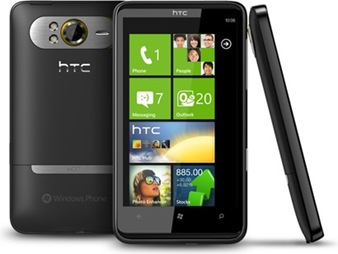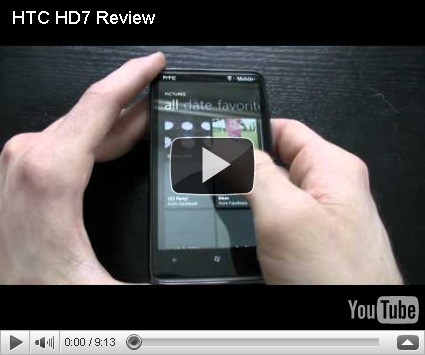The HTC HD7 brings entertainment on the go to a whole new level. Is it enough to beat the EVO 4G and Droid X? Find out in our review.
HTC HD7 Report
The Windows Phone 7 fleet aims at delivering something for everyone. There's the HTC Surround for music lovers, LG Quantum for avid texters, and the Samsung Focus for style conscious users. With a massive 4.3-inch display, Dolby Mobile sound, an a kickstand, the HTC HD7 is an answer to Sprint's EVO 4G and Verizon's Droid X. Of course, those who are fond of the Windows Phone 7 experience and advanced mobile entertainment will want to look into the HTC HD7 for T-Mobile. The phone offers the largest virtual QWERTY out of the Windows Phone 7 family, and is designed to keep you entertained no matter where you go. Will the HTC HD7 have what it takes to defeat the EVO 4G and Droid X? Find out in this review. Design
Without a doubt, the HTC HD7's 4.3-inch WVGA capacitive touchscreen display steals the show. With such a monstrous screen engulfing the landscape of the phone's façade, it is inherently obvious that the HTC HD7 is designed to be a mobile cinema, and the HD7 represents the largest screen on a Windows Phone 7 to date. It's got 16 million colors at a resolution of 800 x 480, and our experience viewing movies was top notch. The screen also offers the largest virtual QWERTY in the Windows Phone 7 lineup. However, just like our experience with the HTC Surround, the HD7's screen does not perform well while swiping and scrolling in the home screens. What happens is that text will become pixilated and translucent, which is highly disturbing. HTC needs to fix this screen bug, as this is not the first time we've encountered this problem. The HTC EVO 4G and Motorola Droid X finally have some competition though, from Mr. Gates & Co., and the we know that HTC does not fool around when it comes to a quality portable multimedia machine. The HTC HD7 even incorporates a flip-out kickstand and features high quality Dolby Mobile and SRS WOW HD surround sound for an even richer experience. We will say that the HTC HD7 is one of the premiere multimedia devices on the market.
As far as the rest of the phone, the HTC HD7 is rather plain, sporting only a Power/Lock button, large Volume control, Camera button, USB terminal, and 3.5mm audio jack—a standard fleet of external controls. Being a Windows Phone 7, the HTC HD7 is slightly shafted when it comes to memory, relying on 16GB of NAND flash memory rather than support a removable MicroSD card. Stylistically, the HTC HD7 is one of the sexier phones on the market, featuring brushed metal inlays and a silver accent within the kickstand/camera lens region. The symmetrical headset and reciever bookend the giant screen unobtrusively, and the phone features its three haptic feedback touch buttons along the bottom of the screen—Back, Home, and Search. If HTC really wanted to get crazy, they could have migrated the touch sensitive buttons even further southward and stretched the screen out to 4.4 or 4.5-incher. Now that would have been hot.
Software and Interface
Before we leap into the infamous Windows Phone 7 experience, let's see what the HTC HD7 has to offer in terms of hardware. The phone has a 1GHz Snapdragon processor with Windows Phone 7 OS. The HTC HD7 also incorporates Wi-Fi, Bluetooth 2.1, GPS, and a gyroscope/accelerometer combo for gaming, so the phone is on par with the rest of the Windows Phone 7 lineup. HTC threw in Netflix for movie streaming on the HD7's ample screen, T-Mobile tossed in T-Mobile TV for live and on-demand TV with some free programming, and Slacker Radio was also preloaded on the phone. Unfortunately, the HD7 does not fall in the HD2's footsteps, which offered Transformers 1 and 2 right out of the box. It would have been nice if HTC and T-Mobile gave us something to show off that screen, particularly with Megan Fox in it, but we have to lay down some Netflix cash this time around. T-Mobile did get away with Family Room, which is an application that allows family members to converge and communicate via a virtual chalkboard and update calendars together. Family Room offered real-time notification alerts and allowed us to send pictures, though keep in mind that each family member involved must have a T-Mobile phone that is equipped with Family room, which is quite a marketing ploy if we've ever heard one. Our advice is to call or email your family members in order to stay in touch. There's also that little application called Facebook, which happens to be integrated into the Windows Phone 7 hub interface. All Facebook contacts will appear within the People hub, and can be contacted via email, phone, or any other method that the contact has listed.
The same goes for Music and Videos, which is a direct portal to the HTC HD7's fantastic music and video player with album art, in addition to the Zune store for buying additional music and videos. In order to load our own music or videos onto the HTC HD7, we needed to download the Windows Phone 7 Connector, which functioned quite similarly to iTunes. For gaming, the Xbox Live hub let us create our own avatar and purchase games directly from the store. As you can begin to see, the Windows Phone 7 experience is more like a series of cubbies that house individual interests on the phone. There are only two home screens, and the icons are animated, updating with contact pictures and recent notification tallies.
Microsoft Internet Explorer 8 was our browser. Pinching and double-tapping to zoom was rapid and offered text wrap. Unfortunately, the Windows Phone 7 experience lacks Flash 10.1 support, so we had to rely on YouTube for playing videos. Google Maps is fantastic on the HD7, and we could access an address by simply tapping it within a browser or email. One other setback with the HTC HD7 is that its Marketplace is nothing compared to the Android Market or iTunes Store. After spending time with the Nexus S, we came to the conclusion that the HTC HD7 was not the most advanced experience on the market, but offered a pretty interface.
Call Quality/Battery Life
The art of dialing out was met with our approval, though the HTC HD7 featured one microphone, so the phone was devoid of any noise canceling systems. Rarely did we encounter the dreaded compression-laden background noise blanket, but it would show up in certain calling environments. However, for a T-Mobile phone, the HTC HD7 was a better performer when it came to call quality, and that was a plus.
Battery life was average, as the phone drained to half capacity in the span of 12 hours with some light gaming, Internet browsing, and camera usage. This is definitely a phone you'll have to charge regularly, unlike the awesome Nexus S with the golden battery life we just tested.
Camera
The HTC HD7 has a 5-megapixel camera with dual LED flash. Although the hardware ranks among the more advanced phones on the market, the HTC HD7 produced mediocre images. Never in quite some time have we encountered a camera that exhibited such a strong degree of sharpening. Lines and edges of objects were almost eroding into oblivion, and any dip in lighting brought moderate to heavy dosages of red and blue noise. We're not expecting a stellar performance out of a phone, but we've seen better performances from the iPhone 4, HTC EVO Shift 4G, and Motorola Cliq 2. For controls, the HTC HD7's Auto Focus functioned quite well, though the phone lacked touch focus and we lacked the ability to toggle the light on or off in video mode.
Speaking of video mode, the HTC HD7 captures 720p HD videos, but they might as well be standard-definition because the quality was in that ballpark. We're getting a bit sick of manufacturers tacking on 720p video capability for the cheap marketing ploy, and we've yet to see a Windows Phone 7 that gives us an above average performance. The iPhone 4 and certain Samsung Galaxy S phones have given us hope for the future of HD in the phone world, but HTC really needs to step it up in the camera department if they want to compete.
HTC HD7 – infoSync Diagnosis
As we come to a close with our Windows Phone 7 entertainment machine, we can't help but compare it to the entertainment giants on other carriers, like the HTC EVO 4G and Motorola Droid X. Unfortunately, the Windows Phone 7 experience lags behind the two aforementioned contenders. Part of it has to do with our non-expandable 16GB of NAND flash memory, part of it comes down to the lack of applications from the Marketplace. Also, what about that strange screen glitch that plagued text in the home screens?
Yes, we have a giant 4.3-inch screen, excellent sound quality, and a kickstand. However, look at the EVO 4G's HDMI terminal, access to the Android Market, and superior Android 2.2 OS. Yes, the Windows Phone 7 is pretty and plays nicely with Microsoft Office, Windows Live accounts, Zune, and Xbox Live. But if you're not wired into the Microsoft lifestyle, then the HTC HD7 might not be necessary. T-Mobile also has a fantastic fleet of phones this year, so we recommend exploring your options before settling on this Windows Phone.



No comments:
Post a Comment